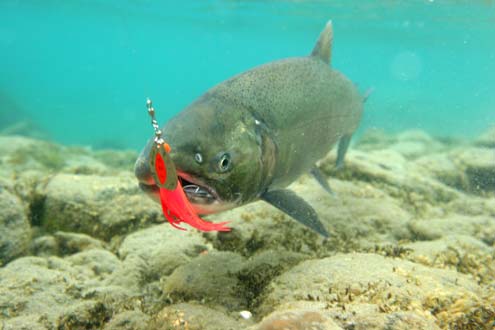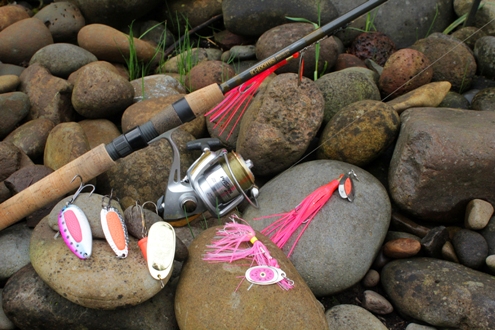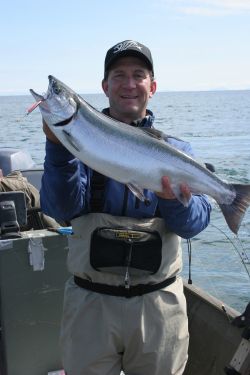
This blog post comes to us from Fish Alaska contributing editor Scott Haugen, whose many angling books are available at his website.
Silver salmon are one of Alaska’s most prized gamefish, and with so many places to pursue coho, finding somewhere to fish is the least of your worries.
At the same time, silvers are a cooperative salmon species, in that they will attack multiple presentations. The fact they’re not as finicky as their king salmon cousins means success rates run high. Be it eggs or jigs fished beneath a float, roe bounced along the bottom, or flashy flies or hardware run through their holding or traveling zones, there’s not much a silver salmon will pass-up, under the right conditions.

Coho are great fish to focus on, not only for their tenacious fights and exquisite table fare, but for their predictability. Once a pod of silvers is located, chances are they will bite something, sooner or later. The key to success, however, is persistence and a willingness to diversify.
Locate
Silver salmon are a schooling fish, and where you find one, more are sure to follow. Knowing this, it’s worth the effort to physically spot fish and learn exactly where they are laying, or perhaps traveling. It makes no difference as to the size of the stream or river being fished, once coho are located, others will be attracted there for the same reasons.
Cut banks, gravel depressions, back-eddies, side-currents, boils, channels and behind rocks are just some of the habitats silver salmon will frequent year after year. As long as the bottom structure doesn’t change too drastically, where you find coho one year, you’ll have a good chance of finding them there again the following year, and the year after that.
Most fishing time is spent targeting staging silvers, that is, fish that have entered a stream, found a spot to relax and are in a holding pattern. Such fish may remain in areas like this for days, even weeks, depending on how far they have to migrate upstream. Others may push through after only a few minutes of holding.
On fish that stage for a short time period, note exactly where they were located and keep at it, for others will follow. Silvers sometimes push upstream, quickly. This is especially true in streams with a big tidal surge, and is even more evident the closer to the mouth you get.
On big rivers, silvers can push upstream a good distance before coming to rest. On small streams they may hold-up 100 yards from the mouth, depending on the system. Conditions cause fish to behave differently in various settings, and being cognizant of this can lead to more fish being caught.
Where fish push through a system in short order, it can be worth dedicating several hours to this spot. The intent here is to target fish as they move through. At peak migration times, fish may steadily be entering into a stream all day long. On streams that are more tidally influenced for fish movement, the rush may come after big tide changes, depending on the river and the situation.

Diversify
Because silvers can be fished in water ranging from a foot in depth to 15 feet or more, and from fast-moving currents to still pools, being able to offer the fish a wide variety of alternatives can be important.
One year I fished a small stream along the Sterling Highway. The coho were holding in about eight feet of water, and though my jig was going right over their noses, I couldn’t buy a strike; I couldn’t keep them away from my float, though. It was early morning, the stream was tannic stained, and the fish absolutely hammered my little foam float as it bobbed across the surface.
Shortening up my leader to a mere four-inches, and pegging my float against the barrel swivel that connected my mainline and leader, I soon had all the fish-catching action I wanted. On this day, the fish were being aggressive. I caught several coho off the top, and later in the day returned to pick up several more off the bottom. It was one of my best days ever for catch-and-release coho fishing in Alaska.
While the hole I fished was perfect for jig fishing, it was too narrow to effectively present lures. After nailing several fish off the surface, I moved downstream, tossed spinners and lures in the middle of the day, and caught more fish along the edges of riffles. Later on I moved back up to the staging hole, dropped my jig to a foot off the bottom, and continued catching fish. Diversifying tactics paid off on this day.
Several times I’ve run in to picky silvers, where the flies, spinners and jigs I dangled in front of them failed to produce a bite. This is where I’ll switch to cured eggs, and almost always get results. The interesting thing here, once the feeding instincts kick-in, they seem to bite on anything. They can be tough to turn-on at times, but once they respond to one presentation, silvers seem to get aggressive on most things thrown at them.
This season, no matter where you fish for Alaska’s prized silver salmon, do so with specific objectives in mind. When going to a river, study it’s anatomy to figure out where fish are laying, or traveling. Once you know where the coho are, determine the best method by which to fish them, and always be ready to offer multiple types, colors and sizes of terminal gear. Pink, pink and white, red, orange and chartreuse are top colors for cohos. Go in prepared, and you’ll come away with all the silvers you want.


